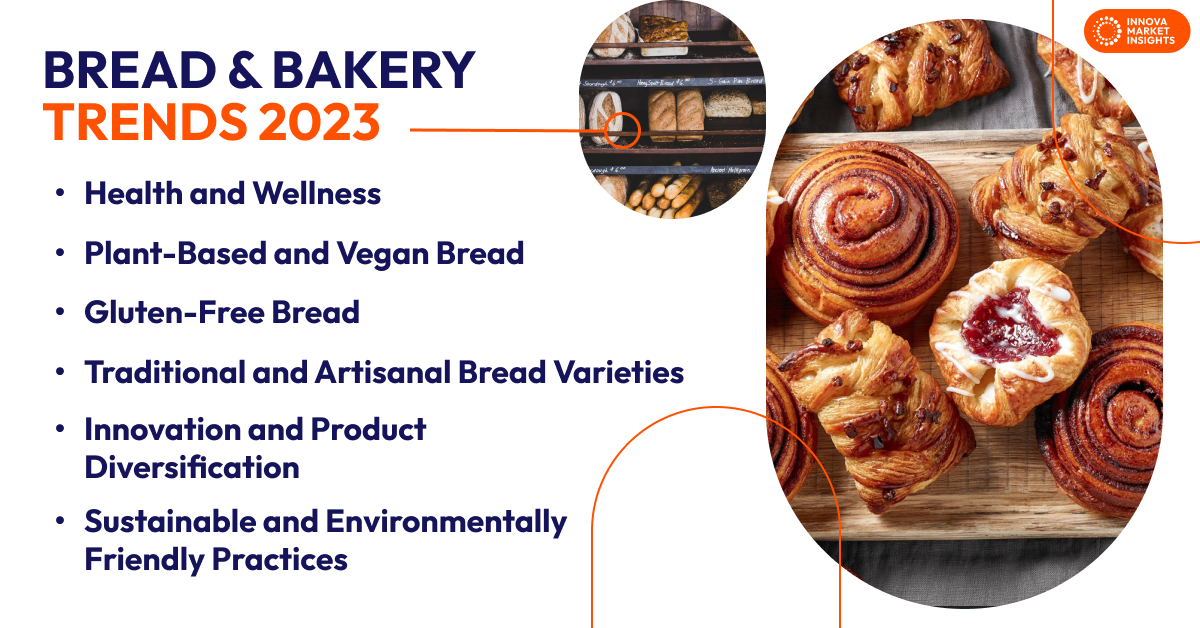Bread is a staple food consumed by 80% of global consumers in the past year alone. It comes in various forms, flavors, and textures, catering to diverse culinary preferences. Between 2018 and 2022, the bread and bread products market witnessed a +2% CAGR in new bread launches. It has also witnessed several global trends that have shaped consumer choices and market dynamics. Here are some of the key trends that are driving the evolution of the bread sector.
Health and Wellness
The increasing demand for healthier options is a prominent trend in the bread market. Consumers continue to place more emphasis on health and are seeking bread products made with whole grains, natural ingredients, and reduced sugar content. This has led to the rise of artisanal and specialty bread types, such as sourdough and multigrain bread, which are perceived as healthier alternatives. Asia is more likely to prefer breads with added health benefits than the global average. This region also had the fastest bread sales and new product introduction growth for 2022 at +6% and +12%, respectively.
Plant-Based and Vegan Bread
With the growing popularity of plant-based diets, there has been a surge in the demand for plant-based and vegan bread products. This surge in demand is reflected in the market, with ‘vegetarian’ and ‘vegan’ being the fastest-growing claims. Bread products are also increasingly citing plant-based claims, including V-label logos and eggless formulas. Western Europe is twice as likely to include vegan claims on new bread entries compared to other regions.
Gluten-Free Bread
Another significant trend is continued rise of gluten-free bread products. Gluten-free diets have gained traction among consumers adopting free from diets as well as those with gluten sensitivities or celiac disease. As a result, manufacturers have introduced a wide range of gluten-free bread options, providing consumers with more choices in the market. Natural claims such as gluten-free are already common in most global regions, but Latin America leads with a higher average portion of bread launches with gluten-free claims. Despite its established position in the bread market, expect to see a further increase in bread launches geared towards gluten-free nutrition.

Traditional and Artisanal Bread Varieties
Consumers are increasingly seeking unique and authentic bread experiences. This has led to the popularity of traditional and artisanal bread varieties. Traditional bread types like baguettes, ciabatta, and naan bread have gained global recognition and are now widely available in many markets. Some consumers use the artisanal bread market for revenge spending to deliver affordable everyday indulgence.
Bread outlets like an artisanal bakery or supermarket bakery also contribute to bakery trends and bread experiences. Globally, 64% of consumers purchase bread at the supermarket, making supermarkets the top market for purchasing bread and bread products. 48% of consumers buy their products at the bakery, making it the second-largest market. Though 30% to 40% of consumers globally view artisanal bakery products as better for price (27%), quality (26%), and taste (22%), one-third of consumers in Europe and North America view in-store bakery products as better for availability, freshness, convenience, and price.
Innovation and Product Diversification
To cater to evolving consumer preferences, the bread market has seen a wave of innovation and product diversification. Manufacturers are introducing new flavors, textures, and formats to attract consumers. This includes the incorporation of ancient grains, seeds, and herbs into bread recipes, as well as the development of gluten-free and low-carb bread options. Some manufacturers have started offering options suitable for the dietary management of chronic kidney disease and other diets with restrictions.
Sustainable and Environmentally Friendly Practices
As sustainability becomes a key consumer concern, the bread market is embracing environmentally friendly practices. This includes sourcing ingredients from sustainable suppliers, reducing food waste, and using eco-friendly packaging materials. These environmentally friendly practices also extend to manufacturers, offering bread products that feature sustainable ingredients, low carbon footprint, or ethical treatment of humans and animals. Consumers are increasingly drawn to bread brands that prioritize sustainability and demonstrate a commitment to the environment.
What’s Next?
The global bread and bread products market is experiencing significant shifts driven by changing consumer preferences and dietary trends. Health and wellness, plant-based options, gluten-free varieties, traditional and artisanal breads, innovation, and sustainability are some of the key trends shaping the market. As consumers continue to seek healthier and more diverse bread options, it is expected that the market will continue to evolve and adapt to meet their needs.
This article is based on our report, “Global Trends in Bread and Bread Products.”
If you are interested in receiving this report, feel free to request a demo through our Click Here.